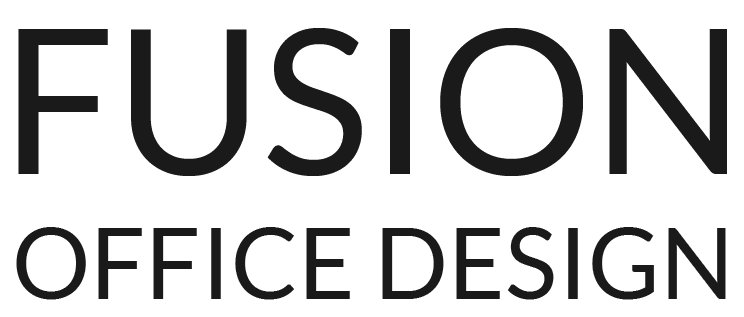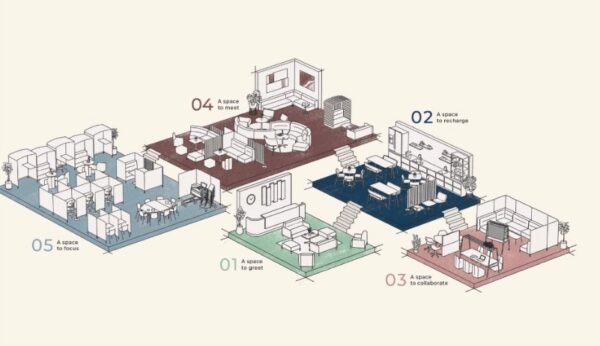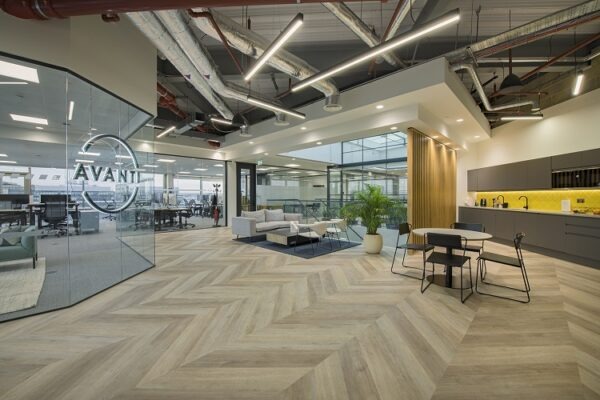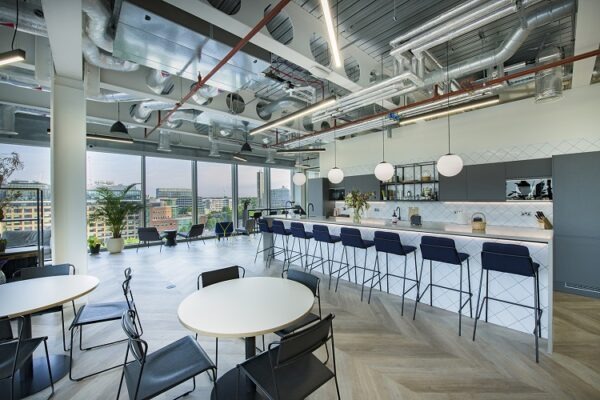What is an office fit-out
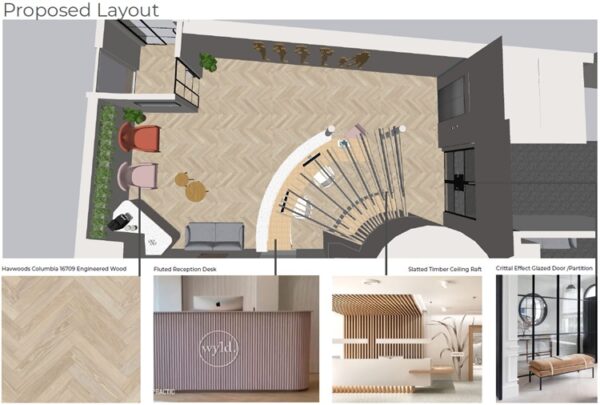
The phrase ‘Office Fit Out’ is a trade term describing the office interior space as its turned into accommodation for occupants (tenants), including partitions, flooring, electrical works, furnishings, decorations and mechanical installations including air conditioning.
Typically there is CAT (category) A fit-out carried out by a Landlord, or sometimes a tenant, where the base build is mostly a raw shell with windows. ‘Shell and core’ being the term used commonly. Where a building requires much of the old fittings and mechanical services removed this can also fall within Cat A scope of works. ‘A’ refers to the work being generic, not specific to any tenant.
A Cat A building may have a suspended ceiling and lights, WCs, and HVAC. A Fire detection system will be installed. An electrical distribution board will also be fitted. The CAT A office could be occupied but there are few power sockets, no meeting rooms, often no teapoint, etc.
Recently there have been a number of ‘plug and play’ offices where a landlord will include data services, power outlets, and meeting rooms, sufficient for tenant needs but not purpose designed.
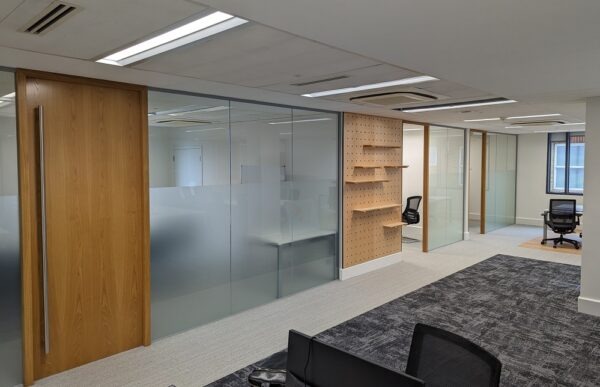
CAT B works are to one single tenant’s sole requirements. A custom build-out. Often Cat B scope of works will be partitioned rooms, tea points, reception and breakout areas, that turn a single large office space (the Demise) into sub-divided areas.
Sub-division then entails changes to lighting and HVAC. Decorative changes, furniture and enhanced electrical works follow on from the division of space.
CAT A work is aimed at making a building interior look smart and modern, with a set of features either making good use of the base architecture, or adding a design theme. Driven largely by the Lettings market a Cat A building is intended to appeal to prospective tenants. An ‘A’ fit-out also significantly speeds up the occupation process as lots of time-consuming work is completed prior to any letting. One downside to this is the subsequent alterations between Cat A and Cat B.
CAT B is aimed at adding all the resources a tenant will require in order to turn a generic office interior into a space suitable for their particular office activities. The spatial design is driven by the ways in which a tenant wants to work and uses of the space. A fit out then implements the alterations in the spatial and design scheme to create an interior.
Office fit-out contract types.
There are two established types of contract for office fit-outs.
‘Traditional’ is the format where an architect and cost-consultant will create the design and scope of works. Specialist consultants for M&E (mechanical and electrical) usually develop details for works alongside the architect. A client-side project manager is also a key part of the Traditional fit-out contract.
The architect usually designs the scheme to be compliant with Building Regs (Building Code) and a specialist building regs consultant will vet the scheme for approval.
Furniture can be part of the process, or handled in tandem.
‘Design and Build’ is a format that brings all the design, consultancy and compliance under one roof. A D&B company will have access to all the necessary capabilities and compliance responsibility.
As a packaged service D&B can rationalise the process (time, contact points, integration of design and specification) and moves risk more towards the contractor. Set against this is a reduction in independent advice that is more a feature in Traditional. In broad terms D&B is an agile process best for small to medium projects. Traditional is more adept for large projects, but does require a degree of process management from the client to obtain best results. Where time is of the essence D&B stands out.
There are several standardised legal contracts available off the shelf for office fit out agreements, including JCT documents, covering both formats.
Timescales for the fit out project.
Our free to obtain project timeline critical path details all the common steps in project managing an office fit-out. Just get in touch and we’ll email the critical path by return.
Projects involving a relocation can be as long as 9-12 months including the building search phase, the design and costing stage, fit out alterations and occupation tasks.
Office Building evaluation is a survey service offered by Fusion to assess a new premises against compliance, hidden costs and potential Landlord defects, which offer a detailed analysis of a building so that Heads of terms can be better negotiated at the outset.
The fit-out design process often takes 4-6 weeks depending on intricacy. Bigger office schemes, 5000 sq ft or more, can take longer as there will be more information to collate, more departments to cater for, and more fit-out alterations to identify.
Contract and cost examination can be several weeks.
Purchasing and lead-times often determine a commencement date.
Compliance with Building Regulations entail communication with approved inspectors or Local Authority. If a Planning Application is involved, say for works externally, this will often run in parallel. A feature of UK building code compliance is that Approved Inspectors, not part of a local authority, can pre-approve a scheme ensuring no delay whilst a design is submitted to a local govt department.
The fit out works themselves can loosely fall into the duration of 2 weeks for every 1000 sq ft with a minimum duration of 3 weeks. Of course simple fit out schemes will be quicker, complicated schemes longer.
Changes to a design scheme, whilst manageable, should be avoided if you can. Likewise any aspect of a design scheme not finalised before commencement can be a cause of delay or cost overrun.
Designing an office fit-out.
Possibly the biggest topic. Office Design. It carries a lot of hopes and fears. You may be changing the organisation through the office interior. The office fit out not only addresses current objectives but will have to work over a 5/10 year duration and adapt in ways we can’t foresee. Individual staff and teams will want bottlenecks and inefficiencies rectified. On top of this the look and feel must be matched to the business culture, but often help to move that culture forward. Oh and it must stand the test of time and not be too dated too soon.
Its possible to write a book on office design. Suffice to say it’s a big part of the process.
Practical advice starts with the basics. How many people, how many rooms. How long should the fit-out last for in relation to the Lease of the space.
Regulatory aspects include designing for safety, both of construction workers and for staff in the finished office. In the jargon this is called ‘principal designer’ and describes responsibilities to design a safe interior.
Sustainable fit-out also starts with the designer, and other specialists involved with the specification. Its crucial to outline the objectives for a scheme before design work starts in earnest.
The look and feel of a fit out is usually the fun part. A relocation can be a catalyst for change within a business, realised through interior and workplace design. Ways of working, spaces designed for biz culture, and process re-engineering, can all be captured in a fit-out design. Staff will often have high hopes for new being better, as well a fear that change could be a negative.
A designer must bring out all the opportunities available from a fit out. Design ideas often start with a desire for change and improvement. That could be the environment inside a building (too cold, too hot, too noisy). Or the layout (not enough meeting spaces). A fit-out can be a manifestation of change within a business. New office equals new attitudes. It can also be a move to hybrid working where the office supports WFH as well as physical presence.
All the wish-list ideas are ingredients for a set of design ideas, presented in visuals and product ideas. Sometimes there will be a theme or concept. Often a design may just be aiming for modern and effective. Your design brief to a fit-out company is the start and should bring many strands together to start the process. Clear thinking on timeline, budget, and business change requirements make for a good design scheme.
Quality of fit out. Budgeting for the project.
Quality is sometimes translated as ‘detail’. How good are the details of the fit-out, what quality level are you envisaging. Clients and designers often use mood images to determine an appropriate quality level and then develop the details of the fit-out scheme to match the perceived quality expectation.
Quality level feeds into a budget. Our fit Out Costs spreadsheet is a free to email document that breaks down the average costs of a London fit out, and also offers high and low options.
At £45.00 (45 pounds) per sq foot (£480.00 per sq metre) the typical fit-out in London would equate to a mid level for quality. Anything above £55.00 per square foot of net lettable space will move into a higher quality level. Below £40 psf would be a value-engineered design, with budget constraints being a priority. These figures include design, and furniture, within a D&B format.
A Traditional format depends on the hourly cost of the architect and consultants. Whereas the ‘builders’ costs might be less, overall figures may be higher.
Quality and workmanship are two separate aspects. A marble counter is a high value material. Chipped and scratched, it’s a low quality installation.
Managing the project
Communication is key. The project manager for the fit-out team coordinates all the trades and suppliers, and liaises with the client and any other parties such as a landlord. Cost-control and program of works typically falls to the overall PM.
The client project manager brings decision-making and cost scrutiny, representing the operational and financial aspects for the client. The client project manager will often be an office manager, facilities manager, or outsourced client-side PM.
A program of works will have a duration and sequence set out. Although the sequence of works might vary its good to have a program so that all parties can check progress. A program will also reveal any items that haven’t been assigned in terms of responsibility.
A golden principle for managing a project refers to the completeness of all decision making prior to starting work. The more a design scheme has items not approved, costs not confirmed, or full extent of works still to be agreed, the more a project can go wrong. ‘Wrong’ can mean costs overshooting, time delays, the interior not being as envisaged, or quality of work being below expectation. Get everything agreed, approved, costed and ordered, and the project is off to a great start. Leave elements to later and you may hit the rocks.
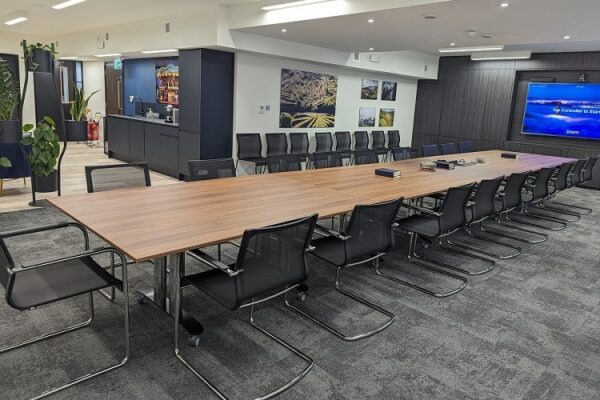
Reinstatement
Sometimes the tail does wag the dog. Reinstatement…putting the office back to the way it was when you took the Lease. In many cases that can be parked and left until handing-back a demise. On the flip side its worth thinking about reinstatement, also known as dilapidations, when considering the fit-out. Major changes need time to repay the investment. If you’re on a shorter Lease its harder to make a financial case to make big alterations only to pay again to undo all the good work. Worth consideration if you are taking a shorter duration Lease.
The 6th Soldier.
Rudyard Kipling’s 6 soldiers includes ‘why’. Why fit out the office. A tick list starts with productivity…the office best suited to your working approach, culture and aligned with business plan aims should give you a return on investment.
Security is another significant force. When you handle data, or financial transactions, pharma and other IP, having control of your own space does seem important.
Managing an organisation, getting everyone aligned, can be a challenge. Having your own space can support this and help get where you want to be.
We all work hard, and having a nice office that is efficient and comfortable shouldn’t be downplayed. Human beings need refreshment, association and collaboration. Motivation used to be the buzzword. Health and wellbeing is commonly used. Whatever the human factors an office can be deployed to good effect in this aspect.
Technology in the workplace hasn’t been mentioned so far. It’s a significant force for change. New tech has altered the office dramatically as it changes the way we work. We’re also cutting the cables so to speak. Wireless, WFH and remote working are so common we’ve forgotten what its like to have data cables everywhere…and power isn’t the umbilical it used to be now that battery technology is advancing. In terms of ‘why’, and office fit out does give you more scope to bring in tech, or react to technology progress. And that’s not going to stop anytime.
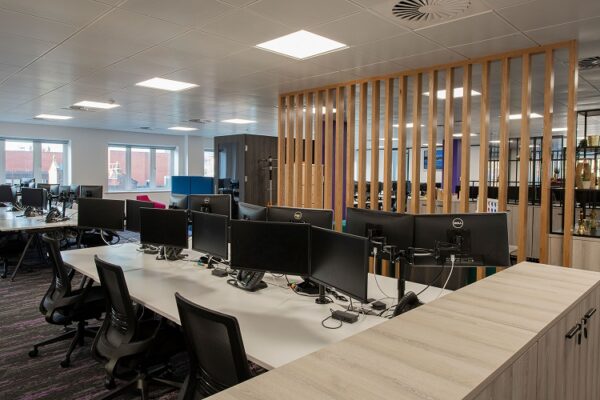
Summary
This article is a description rather than a checklist. A guide to the main aspects of an office fit-out. We hope its useful to explain some of the background. Fusion Office design do have a checklist…get in touch and we’ll gladly email it.
Its common for construction companies to talk about their processes and alignment between client and contractor; the physical activities and project management. Stepping back from this the bigger picture is about the organisation and its plans for the future. Everything else is just a step on the way. When a fit-out starts with the business plan as it relates to a region then the project has a good foundation. That’s the way we do it at Fusion. To see more on the way we work for you click here
